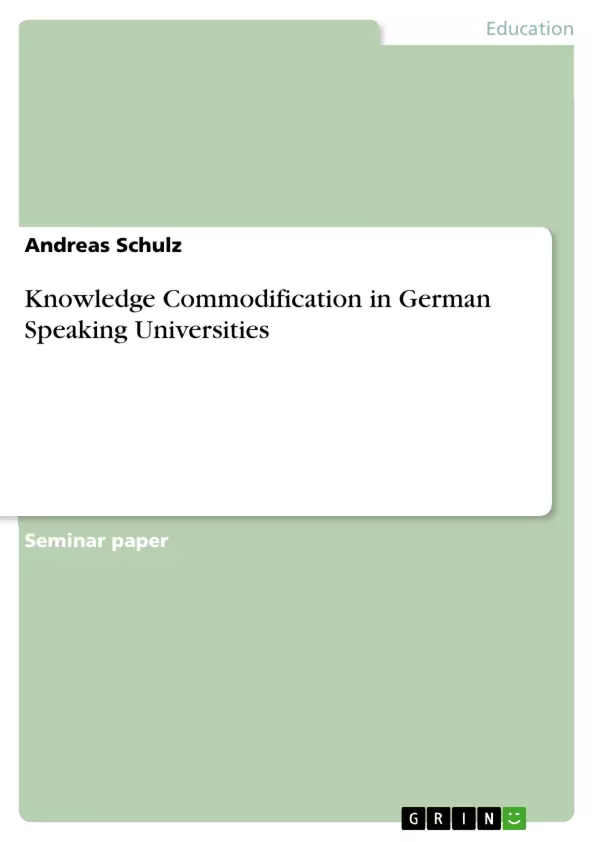The following paper shall examine the processes of commodification in the German speaking academic context and illustrate the “state of the art” of research of the commodification of academic labor on several dimensions: (i) by university research institutions and (ii) by student organizations. It should illustrate, in reference to the theoretical framework by Ursula Huws, the institutional “discussion” of the academic commodification and should demonstrate that there is a lack of research about the commodification and a result of this lack is a missing discourse about these specific aspect of the economization of the university system in Germany, Austria and Switzerland.
The paper is structured in three parts; the first chapter will gives a theoretical introduction to the means of the commodification of intellectual activity and when we talking about economization and the resulting new interdependencies I will connect the Marxist based Framework by Huws with the Governance Concept of Michael Foucault. After these theoretical embedding it follows an empirical overview about the situation in the German speaking academic landscape. Then I like to give a reflection on the topic, sum up the research findings and like to raise some further questions.
“Commodification as the process of transforming things into objects for sale has become a totalizing cultural force” (T-H-R 2003: 5) and it is described as the “essence of our time” (Ley & Harriss 2012). Under advanced capitalism , commodification expands into all corners of social and political life . But not everything useful is a commodity. What makes anything a commodity is the possibility of trading it for profit? They are not only means of production that are traded in this process, not only raw materials and machinery, but also labor or knowledge.
Inhaltsverzeichnis (Table of Contents)
- Introduction: The General Problem of Commodification of the University System.
- Theoretical Framework of Commodification.
- A little Introduction and Overview of the Situation on German Speaking Universities
- Some Conclusions.
- References
Zielsetzung und Themenschwerpunkte (Objectives and Key Themes)
This paper examines the process of commodification within the German-speaking academic context, focusing on the commodification of academic labor. It seeks to illustrate the “state of the art” of research on this topic, exploring the commodification of academic labor by both university research institutions and student organizations.
- The commodification of knowledge and its impact on universities.
- The transformation of academic labor under neoliberal structures.
- The standardization and intensification of academic work.
- The implications of commodification for academic autonomy and research.
- The lack of research and discourse on the commodification of academic labor in the German-speaking context.
Zusammenfassung der Kapitel (Chapter Summaries)
The first chapter provides a theoretical introduction to the concept of commodification of intellectual activity. It connects the Marxist framework of Ursula Huws with the governance concept of Michael Foucault, exploring the interdependencies between economization and the resulting new structures. The second chapter presents an empirical overview of the situation in the German-speaking academic landscape. Finally, the paper reflects on the topic, summarizes the research findings, and raises further questions.
Schlüsselwörter (Keywords)
Commodification, knowledge work, higher education, neoliberalization, academic labor, standardization, intensification, university research, student organizations, German-speaking universities.
- Quote paper
- Andreas Schulz (Author), 2015, Knowledge Commodification in German Speaking Universities, Munich, GRIN Verlag, https://www.grin.com/document/319992



